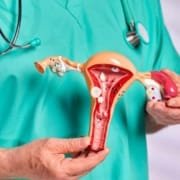Upper Back Pain: Causes, Effective Relief, and When to See a Doctor
What Is Upper Back Pain?
Upper back pain refers to discomfort in the area between the base of the neck and the bottom of the rib cage. This region is known as the thoracic spine, which consists of 12 vertebrae. These vertebrae are connected to the ribs, forming a protective cage around vital organs such as the heart and lungs.
The thoracic spine runs from the lower part of the neck to the start of the lower back, roughly at waist level. It includes intervertebral discs that cushion each vertebra, as well as muscles and ligaments that support and stabilize the spine.
Upper back pain can result from injuries or conditions affecting the bones, discs, muscles, or ligaments in this region. Although less common than neck or lower back pain, upper back pain can be just as disruptive. This is partly because the thoracic spine is less mobile than other parts of the spine, as it works closely with the rib cage to provide stability and protect vital organs.
Upper Back Pain Symptoms
Upper back pain can feel different for each person, depending on the cause and severity. Common ways people describe upper back pain include:
- Sharp or burning pain: Typically felt between the shoulder blades, this type of pain can be sudden and intense, often worsened by movement or certain postures.
- Stiffness or achiness: A dull, persistent discomfort that can limit flexibility and make everyday activities like turning or bending difficult.
- Muscle tightness or spasms: A sensation of tension or “knots” in the muscles, often triggered by prolonged sitting, poor posture, or stress.
- Nerve-related symptoms: Tingling, numbness, or a “pins and needles” feeling that may radiate to the arms, chest, or even fingers, potentially indicating nerve irritation or compression.
Symptoms That Require Immediate Medical Attention
While most cases of upper back pain are mild and improve with self-care, some symptoms may indicate a more serious underlying issue. You should seek prompt medical evaluation if you experience:
- Trauma or injury: Pain following a fall, car accident, or other physical trauma could signal fractures or internal injuries.
- Unexplained weight loss or fever: These symptoms may point to an infection, inflammation, or systemic illness that needs medical attention.
- Nighttime pain or constant discomfort: Pain that disrupts sleep or worsens when lying down can sometimes be a red flag for more serious conditions.
- Neurological changes: Symptoms like numbness, leg or arm weakness, difficulty walking, or loss of bladder or bowel control could suggest spinal cord involvement and require urgent care.
- Pain while breathing, coughing, or sneezing: May be related to lung, heart, or rib issues and should be evaluated promptly.
If your upper back pain lasts longer than 2 to 4 weeks, becomes progressively worse, or is accompanied by any of these warning signs, it’s important to consult a healthcare provider. Early diagnosis can help rule out serious conditions such as spinal fractures, infections, or tumors, and lead to more effective treatment.
Causes of Upper Back Pain
Upper back pain can stem from various injuries, medical conditions, and lifestyle factors. Understanding these causes can help you identify potential triggers and seek appropriate treatment.
Common Causes of Upper Back Pain
These are the everyday culprits behind upper and middle back pain:
- Muscle strains and sprains: Overexertion, heavy lifting, or sudden movements can injure muscles, tendons, or ligaments in your upper back.
- Poor posture: Slouching at your desk, hunching over your phone, or standing crooked can lead to muscle tension and stiffness between your shoulder blades.
- Disk issues: Herniated or bulging disks in the thoracic spine may press on nerves, causing sharp pain in upper back areas.
- Overuse injuries: Repetitive motions from sports or work can strain upper back muscles over time.
- Arthritis: Osteoarthritis can cause gradual wear-and-tear on spinal joints, leading to chronic discomfort.
Lifestyle Factors Contributing to Upper Back Pain
Daily habits often play a significant role:
- Carrying heavy backpacks improperly
- Sitting for prolonged periods without proper back support
- Lack of core strength and back muscle conditioning
- Sleeping in positions that strain the upper back
Less Common But Serious Causes
While rare, these conditions require medical attention:
- Spinal fractures: From trauma or osteoporosis-related compression fractures.
- Spinal stenosis: Narrowing of the spinal canal in the upper back.
- Infections or tumors: These can cause persistent upper back pain that worsens at night.
- Autoimmune conditions: Like ankylosing spondylitis, which causes spinal inflammation.
- Referred pain: Issues with lungs, gallbladder, or digestive organs can sometimes manifest as upper back pain.
Important Note: Upper back pain when breathing or pain that radiates to the chest should be evaluated promptly, as it could indicate lung or heart-related issues.
How Common Is Upper Back Pain?
Research shows that upper back pain affects between 15% to 35% of people at some point in their lives. Unlike other types of back pain, it occurs just as frequently in children and teenagers as in adults, with studies showing it’s slightly more common among girls and women. Poor posture and mental health factors like stress or anxiety often accompany this discomfort, and many adults with upper back pain report aches in other areas of their body too.
Is Upper Back Pain Usually Serious?
Most cases of upper back pain aren’t caused by serious conditions, and many people improve within a few weeks without treatment. However, pain in this area has a higher chance of indicating an underlying health concern compared to neck or lower back pain. That’s why it’s important to pay attention to “red flag” symptoms like:
- Pain that worsens at night
- Severe stiffness in the morning
- Unexplained weight loss with back pain
- Pain that spreads to the chest or affects breathing
Diagnosing Upper Back Pain
When you visit a healthcare provider for upper back pain, they’ll typically:
- Review your medical history and daily activities
- Ask detailed questions about your pain (location, triggers, relieving factors)
- Perform a physical exam testing movement, muscle strength, and reflexes
Diagnostic Tests for Persistent Pain
For pain that doesn’t improve or shows concerning symptoms, your provider may recommend:
- X-rays: Check for bone abnormalities or fractures
- MRI scans: Provide detailed images of soft tissues, disks, and nerves
- CT scans: Offer 3D views of bone and tissue structures
- EMG tests: Evaluate nerve function if tingling or numbness is present
- Blood tests: Identify markers of inflammation or arthritis
Treatment Options for Upper Back Pain
Home Management for Mild Cases
Many cases of upper back pain are mild and can be managed effectively at home with self-care techniques. These approaches focus on relieving tension, reducing inflammation, and preventing further strain:
- Gentle stretching: Simple upper back stretches improve flexibility and reduce stiffness.
- Over-the-counter medications: Pain relievers such as ibuprofen or acetaminophen can ease discomfort and reduce inflammation.
- Posture improvement: Paying attention to posture—especially when sitting or using electronic devices—can prevent muscle fatigue and strain.
- Heat or cold therapy: Applying a cold pack can reduce inflammation during the first 48 hours, while heat packs or warm showers help relax tight muscles later on.
Medical Treatments for Persistent or Severe Pain
If pain persists beyond a few weeks or worsens over time, medical evaluation is recommended. Treatments may include:
- Physical therapy: A physical therapist can develop a customized exercise plan to strengthen the back muscles, improve posture, and prevent recurrence.
- Chiropractic care or manual therapy: Gentle spinal manipulation and mobilization techniques may help relieve tension and improve range of motion.
- Facet joint injections: Anti-inflammatory injections may provide relief when pain originates from spinal joints.
- Imaging-guided treatment: MRI or CT scans may be used to identify herniated discs, nerve compression, or other underlying causes of chronic pain.
- Surgical intervention: Rarely required, surgery such as a laminectomy or discectomy may be considered in cases of severe nerve impingement or spinal instability.
Important Note: Muscle relaxants are generally not recommended for upper back pain due to their limited effectiveness and potential side effects, such as drowsiness or dependency.
Self-Care and Effective Home Remedies for Upper Back Pain
For those with mild to moderate upper back pain, incorporating daily self-care strategies can promote healing and reduce the likelihood of recurrence:
- Non-prescription pain relief: Acetaminophen or NSAIDs (like ibuprofen) can reduce pain and inflammation. Use with caution if you’re over 40 or have digestive or kidney concerns.
- Balanced rest and movement: Short periods of rest may be helpful, but avoid staying inactive for too long. Gentle movement maintains spinal flexibility and muscle strength.
- Low-impact exercises: Activities such as walking, swimming, or gentle yoga improve circulation and reduce stiffness without placing excessive strain on the upper back.
- Heat therapy: Applying a heating pad or taking a warm shower can loosen tight muscles and relieve discomfort between the shoulder blades.
- Posture correction: Practicing good posture, especially when sitting or using screens, can relieve pressure on the upper spine.
- Ergonomic improvements: Adjusting your workspace to include proper chair support, monitor height, and frequent breaks can help prevent pain related to desk work.
Preventing Upper Back Pain
Upper back pain can often be avoided by maintaining a healthy lifestyle and practicing habits that support spinal health. Here are key prevention strategies:
- Maintain strong bones: If you’re at risk for osteoporosis—a condition that weakens bones and increases the risk of vertebral fractures—focus on getting enough calcium and vitamin D. Engage in weight-bearing exercises like walking or resistance training to maintain bone density.
- Stay physically active: Regular moderate exercise strengthens the muscles that support your spine, improves posture, and reduces stiffness. Always begin with warm-up stretches and end with cool-down routines to prevent strain.
- Use safe lifting techniques: Whether lifting weights or everyday objects, avoid straining your upper back by keeping the load close to your body and bending from the knees instead of the waist. If you lift regularly, having your form evaluated by a professional can help reduce injury risk.
- Practice good posture: Poor posture, especially when sitting for long periods, can lead to muscle fatigue and upper back pain. Keep your shoulders relaxed, back straight, and your monitor at eye level to minimize slouching.
- Backpack safety for kids and adults: Ensure backpacks are not overloaded and that both straps are worn evenly. This distributes weight properly and helps prevent strain in the upper and middle back, especially for school-aged children.
When to Seek Medical Care
While most upper back pain improves with self-care, certain symptoms may indicate a more serious condition and should not be ignored. Contact your healthcare provider if you experience:
- Persistent pain: Upper back pain lasting longer than one week without improvement.
- Numbness or tingling: New sensations in your arms, hands, or legs could indicate nerve involvement.
- Severe or worsening pain: Especially if it limits daily activities or disrupts sleep.
- Accompanying symptoms: Such as fever, unexplained weight loss, or changes in bladder or bowel control—these may point to infections, inflammation, or spinal cord compression.
- Pain during deep breathing: Discomfort when inhaling deeply may suggest involvement of the lungs or chest wall, requiring immediate evaluation.
If your symptoms do not improve with home treatment or if you notice any red flags, it’s important to seek medical evaluation. Persistent or severe upper back pain may stem from underlying issues such as herniated discs, spinal arthritis, infections, or even certain cancers. A healthcare provider can conduct appropriate tests and recommend treatments tailored to your condition.
Conclusion
Upper back pain, while often temporary, can significantly impact your daily life. By understanding its causes, practicing preventive measures, and knowing when to seek medical help, you can better manage discomfort and maintain spinal health. Remember that persistent or severe pain, especially when accompanied by neurological symptoms—warrants professional evaluation. With proper care and attention, most people find relief and return to their regular activities. If your upper back pain continues despite self-care, don’t hesitate to consult a healthcare provider for personalized guidance.
Frequently Asked Questions About Upper Back Pain
Is upper back pain a sign of cancer?
While upper back pain is usually due to muscle strain or posture issues, in rare cases, it may signal serious conditions such as spinal tumors or cancer that has spread (metastasized) to the spine. Warning signs include persistent pain that doesn’t improve with rest, unexplained weight loss, night sweats, or pain that worsens at night. If you have any of these symptoms, consult a healthcare provider promptly.
Can bowel issues cause upper back pain?
Yes, gastrointestinal issues such as gallbladder disease, peptic ulcers, or gas buildup can sometimes cause referred pain in the upper back, especially between the shoulder blades. If your pain is accompanied by bloating, indigestion, or abdominal discomfort, a digestive issue may be involved.
Can stress cause upper back and neck pain?
Absolutely. Stress causes the body to tense up, particularly in the neck and shoulder region. Over time, this tension can lead to soreness, muscle spasms, and stiffness in the upper back. Stress reduction techniques like deep breathing, mindfulness, massage, and physical activity can help manage this type of pain.
Why do I wake up with upper back pain every morning?
Morning upper back pain often results from poor sleep posture, an unsupportive mattress, or the wrong pillow. Sleeping on your stomach can strain the spine, while side and back sleeping—with proper pillow support—tends to be better for spinal alignment. Evaluate your sleeping setup to ensure it’s ergonomic and supportive.
Can acid reflux cause upper back pain?
Yes, gastroesophageal reflux disease (GERD) can cause burning sensations that radiate to the upper back, especially after eating or when lying down. If your upper back pain improves with antacids or is accompanied by heartburn, it may be digestive in origin rather than muscular or skeletal.
How long does upper back pain typically last?
Most cases of mild to moderate upper back pain caused by muscle strain or posture issues resolve within 2 to 4 weeks. However, if the pain persists longer than three months, it’s considered chronic and may require a medical evaluation to identify any underlying condition, such as disc issues or arthritis.
Is upper back pain linked to lung problems?
Yes, lung-related issues like pneumonia, pleurisy, or even a pulmonary embolism can cause sharp pain in the upper back, particularly during deep breathing or coughing. If your upper back pain is accompanied by fever, cough, or difficulty breathing, seek immediate medical care.
What’s the best sleeping position for upper back pain?
Back sleeping is typically recommended—placing a small pillow under your knees helps maintain spinal alignment. Side sleepers should use a supportive pillow and may benefit from hugging a pillow to keep their shoulders aligned. Avoid sleeping on your stomach, as it can strain the spine and neck.
Can dehydration cause upper back pain?
Dehydration may indirectly contribute to upper back discomfort by affecting the spinal discs, which rely on proper hydration to cushion the vertebrae. When fluid levels drop, the discs can become less effective at shock absorption. Drinking at least 8 glasses of water daily supports spinal and muscular health, especially during physical activity.
Do upper back braces work for pain relief?
Upper back braces can provide short-term support and improve posture during certain activities, such as lifting. However, long-term use is discouraged as it may weaken core and back muscles. Braces should be used temporarily and in combination with exercises that strengthen the upper back and improve posture.










